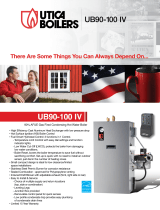
BMK 5000-6000 Boiler INSTALL and STARTUP GUIDE
CONTENTS
Page 2 of 98 AERCO International, Inc. • 100 Oritani Dr. • Blauvelt, NY 10913 OMM-0123_0A
05/30/2017 Ph.: 800-526-0288 GF-207
TABLE OF CONTENTS
FOREWORD .............................................................................................. 5
SECTION 1: SAFETY PRECAUTIONS ..................................................... 9
1.1 WARNINGS & CAUTIONS ................................................................................................... 9
1.2 EMERGENCY SHUTDOWN ...............................................................................................10
1.3 PROLONGED SHUTDOWN ...............................................................................................10
1.4 IMPORTANT – FOR MASSACHUSETTS INSTALLATIONS ...............................................11
SECTION 2: INSTALLATION .................................................................. 13
2.1 INTRODUCTION.................................................................................................................13
2.2 RECEIVING THE UNIT .......................................................................................................13
2.3 UNPACKING .......................................................................................................................13
2.4 SITE PREPARATION .........................................................................................................14
2.4.1 Installation Clearances ..................................................................................................14
2.4.2 Setting the Unit .............................................................................................................16
2.4.3 LIFTING PROVISIONS .................................................................................................17
2.4.4 MULTIPLE UNIT INSTALLATIONS ...............................................................................17
2.5 SUPPLY AND RETURN PIPING .........................................................................................18
2.6 PRESSURE RELIEF VALVE INSTALLATION ....................................................................19
2.7 PRESSURE/TEMPERATURE GAUGE INSTALLATION .....................................................19
2.8 CONDENSATE DRAIN AND PIPING ..................................................................................20
2.9 GAS SUPPLY PIPING ........................................................................................................22
2.9.1 Gas Supply Specifications ............................................................................................22
2.9.2 Manual Gas Shutoff Valve ............................................................................................23
2.9.3 External Gas Supply Regulator .....................................................................................23
2.10 AC ELECTRICAL POWER WIRING ..................................................................................25
2.10.1 Electrical Power Requirements ...................................................................................26
2.11 FIELD CONTROL WIRING ...............................................................................................27
2.11.1 Outdoor Air & Air Sensor Common .............................................................................28
2.11.2 AIR TEMP SENSOR ...................................................................................................29
2.11.3 O
2
SENSOR (+ & –) ....................................................................................................29
2.11.4 SPARK SIGNAL (+ & –) ..............................................................................................29
2.11.5 ANALOG IN ................................................................................................................29
2.11.6 VALVE FEEDBACK ....................................................................................................29
2.11.7 SHIELD (SHLD & SHLD) ............................................................................................30
2.11.8 ANALOG OUT ............................................................................................................30
2.11.9 RS485 Comm (+, GND, & -) ........................................................................................30
2.11.10 RS232 Comm (TxD & RxD) ......................................................................................30
2.11.11 VFD/Blower (0-10 & AGND) ......................................................................................30
2.11.12 Interlocks ..................................................................................................................30
2.11.13 Fault Relay (NC, COM, & NO) ..................................................................................31
2.11.14 Auxiliary Relay Contacts (NC, COM, & NO) ..............................................................31
2.12 FLUE GAS VENT INSTALLATION ....................................................................................32
2.12.1 MASSACHUSETTS INSTALLATIONS ........................................................................32
2.13 COMBUSTION AIR ...........................................................................................................33

























